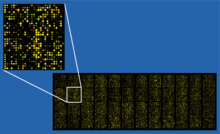DNA chip technology
The DNA microarray (synonym DNA microarray ) is a biochemical and bioinformatic method for determination of amounts of various DNA . It is a variant of the microarray (synonym chip ) with DNA. Microarrays are primarily used to determine relative changes in gene expression. Actually, the differences in the amount of mRNA from two different treated cells are measured. Since DNA is much more robust than RNA, reverse transcriptase is used to extract cDNA from cellular RNA. This then binds to the immobilized DNA probes on DNA chips.
properties
DNA chip technology uses semiconductor technology, among other things , to apply known genes to a fingernail-sized plastic or glass plate, the microarray , as gene probes . Each test field on a microarray has a defined sequence. By incubating with fluorescence-labeled DNA in solution, the sites with bound DNA on the microarray and thus the DNA sequence are identified. This allows the gene expression of a genome and changes in it to be measured.
With the method developed by Stephen PA Fodor since the late 1980s , over 100,000 known genes can be identified in patient samples to be examined from different tissues . The individual fields of the microarray are coated with single-stranded pieces of DNA (as cDNA ). Microarrays are used to determine relative changes in gene expression. But they can also be used for genotyping. By adding the test samples marked with a red and green fluorescent dye , these bind to the DNA in the chip if the base sequence is complementary . The position, intensity and wavelength of the resulting mixed color are detected with a high-resolution laser camera and provide information about differences in the expression of the genes between the two samples, e.g. B. in different organ areas.
In 1994 Affymetrix launched the first commercially available DNA chip, the “ HIV Gene Chip”. Today there are special arrays for genomic DNA, plasmids , PCR products and long oligonucleotides for a wide range of applications .
Surface chemistry of the chips
Often one works with aldehyde slides , in which aldehyde groups are attached to the surface of the chips, which bind the amino-modified oligonucleotides via an imine formation (covalent bond).
- Epoxy-modified slides: amino-modified oligos bind to the epoxy group to form an amine.
- Streptavidin- modified slides: Biotin- modified oligos bind to the protein. (The tetramer streptavidin has four binding sites, each of which can bind a biotin)
- NHS slides: These slides are coated with NHS ester groups. An amide (NHS = N-hydroxysuccinimide ) is formed by an amino-modified oligo .
- Aminoslides: unmodified oligo binds at an undefined point during exposure to light in the UV range (undefined reaction).
Individual evidence
- ^ RN Nazar, P. Chen, D. Dean, J. Robb: DNA chip analysis in diverse organisms with unsequenced genomes. In: Molecular biotechnology. Volume 44, Number 1, January 2010, ISSN 1559-0305 , pp. 8-13, doi : 10.1007 / s12033-009-9212-6 , PMID 19757211 .
